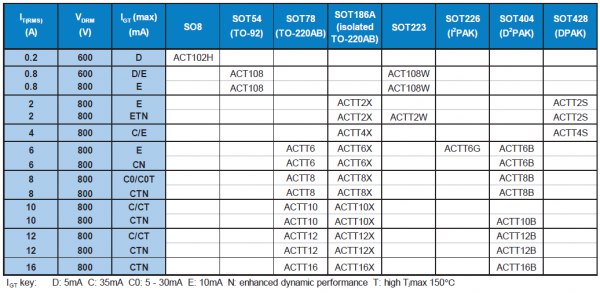A Power Semiconductor with benefits of small size, simple structure and reliable performance, Thyristors are widely used in the electronic control of Home Appliances and industrial applications. Triacs , as bi-directional thyristors, are the only semiconductor devices that can control current in both directions to directly control AC loads like induction motors, universal brush motors, AC valves and solenoids, electric heaters, etc. as used in White Goods and small home appliances as well as industrial applications.
False triggering when a triac is in the offstate can be a problem in some applications. System noise, unsuppressed load switching and other transients on the AC line can introduce high overvoltages and high dV/dt across the triac. Exceeding a triac’s VDRM and dVD/dt capability is a major cause of false triggering. The triac may then be damaged if the load current rises too fast (excessive dIT/dt > 100A/μs).
WeEn Semiconductors, as a leading supplier to the worldwide thyristor market, is constantly developing new designs and enhanced technologies to yield better performance, higher reliability and products that are easy to use. Based on our unique Planar Passivation technology, which is used on all our thyristors, we have introduced and continue to expand our product families with embedded overvoltage protection:
- AC Thyristors (ACT)
- AC Thyristor Triacs (ACTT)


The ACT & ACTT series products can clamp overvoltage transients without false triggering into conduction.

This sets them apart from conventional 3Q and “Snubberless” triacs, which are not guaranteed to clamp and can spontaneously turn on if an overvoltage exceeds their voltage-blocking capability. The ability to clamp instead of turning on reduces a major cause of false triggering.
During overvoltage clamping, the transient energy is safely dissipated in a region on the silicon chip that’s designed for that purpose. It is not a random or risky event as can be the case with older technologies, especially non-planar. As clamping current increases, the device will eventually turn on as a self-protection feature to avoid permanent damage. The difference from conventional triacs is turn-on at milliamperes instead of microamperes of clamping current.
The screen shots compare the overvoltage clamping performance of ACTT and conventional triac. There is effectively no clamping with the conventional triac.
The clamping feature withstands 2000 – 2500V overvoltage transients to IEC 61000-4-5 standard.
In addition to its overvoltage clamping capability, WeEn’s technology possesses the industry’s highest false trigger immunity guarantees with top products boasting a min dVD/dt guarantee of 2000V/μs@Tj = 150°C(ACTT12-800CTN). These device capabilities maximise the whole system noise immunity and false trigger immunity.
WeEn Semiconductors has a comprehensive ACT and ACTT offering, with products covering IT(RMS) from 0.2A to 16A and VDRM from 600V to 800V. There are multiple package options and most parts have Tj(max) capability of 150°C.
WeEn continues to develop more ACT / ACTT products. A recent addition to the portfolio is the ACTT2W-800ETN. This is the first 2A-rated device in SOT223 with 150°C Tj(max) and overvoltage clamping function. Its excellent immunity, dynamic performance and inrush capability bring major benefits to engineers for their small load electronic designs.



